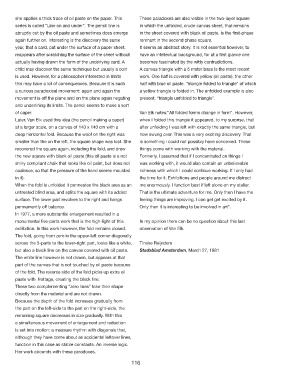Page 120 - The 70s - ABC of the material
P. 120
she applies a thick trace of oil paste on the paper. This These paradoxes are also visible in the two-layer square
series is called “Line on and under”. The pencil line is in which the unfolded, crude canvas sheet, that remains
abruptly cut by the oil paste and sometimes does emerge in the sheet covered with black oil paste, is the first-phase
again further on. Interesting is the discovery the same remnant in the second phase square.
year, that a card, put under the surface of a paper sheet, It seems an abstract story. It is not essential however, to
reappears after scratching the surface of the sheet without have an intellectual background, for at a first glance one
actually having drawn the form of the underlying card. A becomes fascinated by the witty contradictions.
child may discover the same technique but usually a coin A canvas triangle with a 5 meter base is the most recent
is used. However, for a philosopher interested in limits work. One half is covered with yellow (oil paste), the other
this may have a lot of consequences. Because it is such half with blue oil paste. “triangle folded to triangle” of which
a curious paradoxical movement: again and again the a yellow triangle is folded in. The unfolded example is also
movement is off the plane and on the plane again negating present, “triangle unfolded to triangle”.
and underlining its limits. The pencil seems to make a sort
of caper. Van Elk notes:”All folded forms change in form”. However,
Later, Van Elk used this idea (the pencil making a caper) when I folded this triangle it appeared, to my surprise, that
at a larger scale, on a canvas of 140 x 140 cm with a after unfolding I was left with exactly the same triangle, but
deep horizontal fold. Because the woof on the right was now swung over. This was a very exciting discovery. That
smaller than the on the left, the square shape was lost. She is something I could not possibly have conceived. These
recovered the square again, including the fold, and drew things come with working with the material.
the new square with black oil paste (this oil paste is a not Formerly, I assumed that if I concentrated on things I
shiny compliant chalk that looks like oil paint, but does not was working with, it would also contain an unbelievable
coalesce, so that the pressure of the hand seems moulded richness with which I could continue working. If I only had
in it). the time for it. Exhibitions and people around me distract
When the fold is unfolded it permeates the black area as an me enormously. I function best if left alone on my atelier.
untreated blind area, and splits the square with its added That is the ultimate adventure for me. Only then I have the
surface. The lower part revolves to the right and hangs feeling things are improving. I can get get excited by it.
permamently off balance. Only then it is interesting to be involved in art”.
In 1977, a more substantial enlargement resulted in a
monumental five-parts work that is the high-light of this In my opinion there can be no question about this last
exhibition. In this work however, the fold remains closed. observation of Van Elk.
The fold, going from zero in the upper-left corner diagonally
across the 5-parts to the lower-right part, looks like a white, Tineke Reijnders
but also a black line on the canvas covered with oil paste. Stadsblad Amsterdam, March 27, 1981
The white line however is not drawn, but appears at that
part of the canvas that is not touched by oil paste because
of the fold. The reverse side of the fold picks up extra oil
paste with frottage, creating the black line.
These two complementing “zero lines” take their shape
directly from the material and are not drawn.
Because the depth of the fold increases gradually from
the part on the left-side to the part on the right-side, the
remaining square decreases in size gradually. With this
a simultaneous movement of enlargement and reduction
is set into motion: a measure rhythm with diagonals that,
although they have come about as accidental leftover lines,
function in this case as stable constants. An inverse logic.
Her work abounds with these paradoxes.
116

